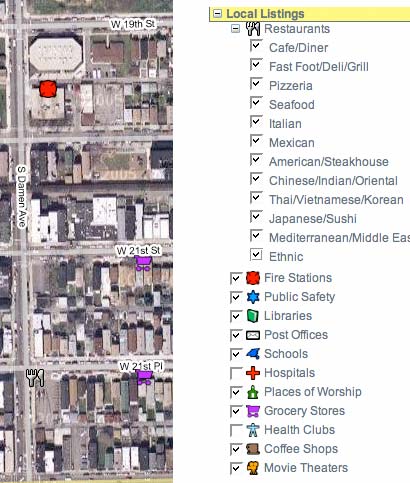In the September 16 update, Google Earth (but not Maps) got new improved data for Brussels. The rest of Belgium, however, including Antwerp and Bruges, still looks rather smudgy at close range. No doubt the country will eventually be given the high-res treatment, but until then you can see the data Google will probably buy, online: aeroGRID.be. Here’s grandma’s house.
Category Archives: Content
3Dsolar, or, where is the portal network link?
3Dsolar is a budding collection of weather overlays and Landsat, USGS ortho, topo, and Modis rapid response map overlays wrapped into a neat network link. It doesn’t just update, but also updates itself with new overlays as they get added, as only network links can.
Big picture: If we take the Google-Earth-as-browser meme and run with it, then the network links are the equivalent to frequently updated websites. It’s surprising, then, that while we’ve seen a lot of individual hacks and proofs of concept that use server-side PHP or ASP to scrape RSS news feeds, say, or convert WML, companies have not yet taken to opening up shop on Google Earth. Where are the “portal” network links, of which 3D Solar is a kind of proof of concept?
Publishing for Google Earth via KML is not like using Google Maps, where terms and restrictions apply. Nobody needs a licence to publish for MS Internet Explorer either. (Imagine!) There is nothing keeping anyone from adding ads to their own Google Earth network links — if the content is compelling enough, the ads will be fine.
So does this mean that if the Yahoos and CNNs and BBCs don’t develop their own branded network links, the geek shall inherit the Google Earth by hack and by crack? (Language usage note: Sorry about that.)
They might, but here is the main problem: scalability. That one network link of the Space Shuttle and the International Space Station that I made still eats up not insignificant PHP processing power (60,000 hits in the last two weeks — half of the site total). Anyone making a successful portal network link needs to be allowed to make money off the content to pay for the servers. If you’re CNN you’re allowed to make money off your own stuff, but if you’re a hacker scraping CNNs content, you can’t, which limits your financial resources.
Of course, if Google were to produce some kind of hosted service for the server-side scripting that powers network links, (“2GB for Gmail, 2GHz for Google Earth”), then hacker creativity would suddenly be scalable, while Google gets to have yet another information flow to own, analyze and monetize. And it would make Google Earth even more compelling.
Fall guy
From the maker of FlickrFly comes UKAutumnColour. Rob Roy has created a network link that scrapes a UK Forestry Commission page for current foliage colors across the country and displays them in Google Earth.
The ultimate mashup
Can you mash up both Earth and Maps? Chicago Real Estate broker Prudential Preferred Properties certainly had a go. Writes Chris Janseen:
Thought you might like to check this out – been following the progression of some of the Google Earth uses out there to use in my own and I noticed that Prudential have merged the Google Earth local search directly into their Google Maps — it is pretty nice, good middle ground between the desktop GE app with the added benefit of being built right into the browser. Thought you may want to check out some progress of them.
You need to register to use it, it won’t work in Safari, you have to zoom in tight and there are no local listings outside Chicago, but this Google Map certainly carries some of the features that until now only Earth had. Look:

I guess this means the challenge of depicting layers on Google Maps has been solved, at least for placemarks. (Prudential also does a straight-up Google Earth implementation, as explained here.)
Rapa Ennui
I too went looking for Easter Island during one of my first forays onto Google Earth, only to find some of the lowest-resolution imagery in the database. That’s probably because it’s one of the most remote islands around, and in any case the situation can be remedied by overlays, but as France’s Le CyberRider illustrates with screenshots, this is one spot where NASA’s World Wind beats Google Earth hands down. Good to be reminded now and again that there is competition out there.
(PS, I’ve been lucky enough to make it to Easter Island, and I can highly recommend this beach. Truly one of the world’s finest.)
Italian villa discoverer on TV
Luca Mori, who discovered a Roman Villa using Google’s mapping tools, writes a followup post that includes a link to the TV broadcast showing shots of him walking through the fields in question, interspersed with screenshots of Google Earth. The segment is at 21.30 minutes into the stream.
I can’t wait for the remote parts of the world to enjoy the same resolutions as the cities. I think there are many more such discoveries coming.
Alternative Google Earth hotspots.
Bored by Google’s own Top 10 Google Earth hotspots? Everything isn’t Under Control has a slightly more macabre list of top 8 hotspots.